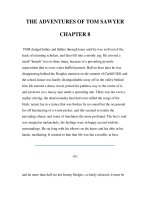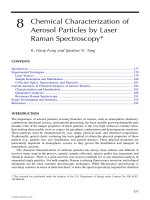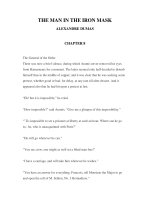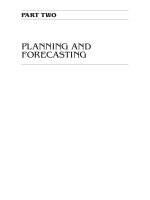BED, BANK & SHORE BED, BANK & SHORE PROTECTION - CHAPTER 8 pdf
Bạn đang xem bản rút gọn của tài liệu. Xem và tải ngay bản đầy đủ của tài liệu tại đây (1.75 MB, 47 trang )
BED, BANK & SHORE
BED, BANK & SHORE
PROTECTION
PROTECTION
Lecturer: Pham Thu Huong
Lecturer: Pham Thu Huong
Email:
Email:
Faculty of Coastal Engineering
Faculty of Coastal Engineering
Chapter 8
Chapter 8
Ships
Ships
–
–
Loads, Stability and erosion
Loads, Stability and erosion
(3 class hours)
Content
Content
8.1 Introduction
8.2 Loads
8.3 Stability
8.4 Erosion
8.5 Summary
Introduction
Introduction
In inland waterways, ships may cause wave:
•
Primary wave: starts with the front wave,
followed by the depression and ending with the stern
wave
→ severe attack on the banks (narrow navigation
channels)
• Secondary wave: The much shorter waves that
originate from the hull (plays an important role in larger navigation
channels)
• Propeller wash: The currents caused by the
ship's propeller
(it is particularly important when ships manoeuvre near
a berthing place or a jetty)
Introduction (cont)
Introduction (cont)
Most damage on revetment cause by:
• large ships ~ sailing slowly
Æ erosion due to return current
• small service crafts, tugs… ~ sailing fast
Æ bank erosion due to secondary waves
Introduction (cont)
Introduction (cont)
Flow around fixed object & moving object in
stagnant water:
Introduction (cont)
Introduction (cont)
Phenomena around a
Phenomena around a
moving ship in a waterway
moving ship in a waterway
Introduction (cont)
Propeller wash
Loads
Loads
Limit speed:
The speed of displacement-type ships can not exceed the
celerity of their own generated waves, unless they are being
towed by another (longer) ship.
Assuming that the maximum wave length caused by a ship is
equal to the ship’s length, the limit speed can be approximated:
2
tanh
2
tanh
2
2
l
gT h
c
gL h
Vc
L
L
LcT
π
π
π
π
⎫
=
⎪
==
⎬
⎪
=
⎭
Definition in 1-d approach
Loads (cont)
Loads (cont)
A
s
= B.D : cross-section area of the ship
A
c
= b.h : cross-section of the waterway
v
s
: water flows
u
r
: return flow
z : water-level depression
limit
limit speed:
(
)
()()
2
2
Bernoulli :
22
continuity:
sr
s
ssr
vu
v
hhz
gg
bhv bh BD bz v u Q
+
+=−+
=
−− +=
(
)
(
)
0
s
dv u Ac As bz
dQ
dz dz
+−−
=
=
()
22/3
1/3
3
1
22
sl l
c
AV V
Agh
gh
+
−=
Combine this with Bernoulli:
Maximum speed is reached when return flow becomes critical,
i.e. when derivative of return flow to waterlevel becomes zero
Loads (cont)
Loads (cont)
limit speed a a function of blockage A
limit speed a a function of blockage A
s
s
/A
/A
c
c
()
22/3
1/3
3
1
22
sl l
c
AV V
Agh
gh
+
−=
Loads (cont)
Loads (cont)
limit speed as a function of waterdepth
and blockage
Loads (cont)
Loads (cont)
For the purpose of bank design, a speed
of 90% of V
l
is recommended
primary waves
primary waves
()
2
2
2/
1/ / 1
1
1
1/ /
s
sc
s
r
sc
v
zh
gh
AA zh
v
u
AA zh
gh gh
−
=
−
−−
⎡⎤
=−
⎢⎥
−−
⎣⎦
Loads (cont)
Loads (cont)
The water-level depression (z) and the return current
(ur) can be calculated in A dimensionless form:
waterlevel depression as a function of blockage
Loads (cont)
Loads (cont)
return flow velocity as function of blockage
Loads (cont)
Loads (cont)
deviation from the 1-d case (Eccentric position ship):
2
11
ecc r ecc r
yy
z
zuu
bb
−
⎛⎞ ⎛⎞
=+ =+
⎜⎟ ⎜⎟
⎝⎠ ⎝⎠
max
1.5
ecc
z
z=
Loads (cont)
Loads (cont)
Multiple ships (when two ships encounter or when a ship
overtakes another one):
origin of diverging and transverse waves
origin of diverging and transverse waves
Secondary waves
Secondary waves
Loads (cont)
Loads (cont)
- Secondary waves are formed by a number of periodic waves,
a wave train
- Secondary waves are caused by the pressure pattern due to
the discontinuities in the hull profile
Secondary wave pattern
Secondary wave pattern
Loads (cont)
Loads (cont)
Secondary wave pattern
Secondary wave pattern
Loads (cont)
Loads (cont)
Fr
< 0.75,
- the cusp locus line is at an angle of about 20
o
with the sailing line
- and the direction of propagation of the cusps is at an angle of
about 35
o
with the sailing line Æ hence the angle of approach for a
bank parallel to the sailing line is 55
o
.
Fr
= 1, transverse and diverging waves coincide
Fr
> 1 transverse waves can no longer exist
s
v
Fr
gh
=
secondary wave height measurements
secondary wave height measurements
Loads (cont)
Loads (cont)
1/3
4
Hs
F
r
hh
ζ
−
⎛⎞
=
⎜⎟
⎝⎠
ζ : ship's geometry
ζ= 1.2 gives a reasonable upper limit of the
experimental data
s : distance from ship’s sailing line
example (1)
example (1)
Given: ship 10 m wide, draught 3 m, ship sails 10 m from bank (y= 5 m)
canal 40 m wide, 5 m deep
Calculate: Maximum Wave height
Limit speed: A
s
/Ac = (10*3) / (40*5) = 0.15
fig 8.4
V
l
/√gh = 0.55 → V
l
= 3.8 m/s design speed 0.9*3.8=3.4 m/s
Use fig. 8.6
z/h=0.083 → z=0.42 m
Ship sails 10 m from bank (y= 5 m), so
z
max
=1.5((1+2*5/40)*0.42 = 0.78 m
u
r
= 0.15 *√gh = 1.04 m
incl. excentricity: (1+5/40)*1.04 = 1.17 m/s
eq. 8.6 and 8.7
H = 1.2 h(s/h)
-0.33
*v
4
/(gh)
2
=
1.2*5*(10/5)
-0.33
*3.4
4
/(10*5)
2
= 0.27 m
eq. 9.8
standard values in the Netherlands
standard values in the Netherlands
Wave heights (m) Currents (m/s)
Wind waves Ship waves Natural current Return current
Lakes
Canals
Rivers
Small waters
0.25 – 1.00
0.10 – 0.25
0.25 – 1.00
0.10 – 0.20
0.10 – 0.50
0.25 – 0.75
0.25 – 0.75
n.a.
0.1 – 0.5
0.5 – 1.0
1.0 – 2.0
0.2 – 1.0
0.1 – 0.25
0.5 – 1.0
0.5 – 1.0
n.a.
Data from CUR 197
“Breuksteen in de praktijk”
The Suez Canal
The Suez Canal









